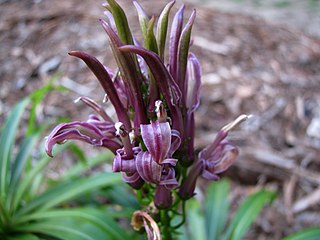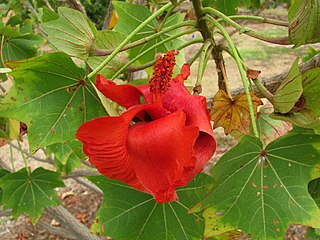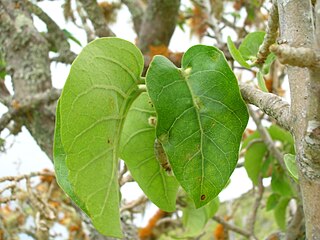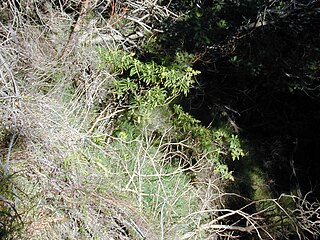Aiea or ʻAiea may refer to:
Located about 2300 miles (3680 km) from the nearest continental shore, the Hawaiian Islands are the most isolated group of islands on the planet. The plant and animal life of the Hawaiian archipelago is the result of early, very infrequent colonizations of arriving species and the slow evolution of those species—in isolation from the rest of the world's flora and fauna—over a period of at least 5 million years. As a consequence, Hawai'i is home to a large number of endemic species. The radiation of species described by Charles Darwin in the Galapagos Islands which was critical to the formulation of his theory of evolution is far exceeded in the more isolated Hawaiian Islands.
Hawaiian hibiscus are seven species of hibiscus native to Hawaii. The yellow hibiscus is Hawaii's state flower. Most commonly grown as ornamental plants in the Hawaiian Islands are the non-native Chinese hibiscus and its numerous hybrids, though the native Hibiscus arnottianus is occasionally planted.

The genus Pritchardia consists of between 24 and 40 species of fan palms found on tropical Pacific Ocean islands in Fiji, Samoa, Tonga, Tuamotus, and most diversely in Hawaii. The generic name honors William Thomas Pritchard (1829-1907), a British consul at Fiji.

Vaccinium reticulatum, known as ʻōhelo ʻai in Hawaiian, is a species of flowering plant in the heather family, Ericaceae, that is endemic to Hawaii. It grows at altitudes of 640–3,700 m (2,100–12,140 ft) on lava flows and freshly disturbed volcanic ash on Maui and Hawaiʻi, and less commonly on Kauaʻi, Oʻahu, and Molokaʻi. Adaptations to volcanic activity include the ability to survive ash falls of over 25 cm (9.8 in) depth.

Rubus hawaiensis, also called the ʻĀkala, is one of two species commonly known as Hawaiian raspberry, endemic to Hawaii. It is found on the islands of Kauaʻi, Molokaʻi, Maui, O'ahu, and Hawaiʻi in mesic to wet forest at elevations of 600–3,070 m (1,970–10,070 ft). In most areas it is not common, but in some places it can be a dominant member of the understory vegetation. Although superficially similar to the other Hawaiian species, Rubus macraei, the two are believed to be derived from separate dispersals to Hawaii.

The Hawaiian lobelioids are a group of flowering plants in the bellflower family, Campanulaceae, subfamily Lobelioideae, all of which are endemic to the Hawaiian Islands. This is the largest plant radiation in the Hawaiian Islands, and indeed the largest on any island archipelago, with over 125 species. The six genera involved can be broadly separated based on growth habit: Clermontia are typically branched shrubs or small trees, up to 7 metres (23 ft) tall, with fleshy fruits; Cyanea and Delissea are typically unbranched or branching only at the base, with a cluster of relatively broad leaves at the apex and fleshy fruits; Lobelia and Trematolobelia have long thin leaves down a single, non-woody stem and capsular fruits with wind-dispersed seeds; and the peculiar Brighamia have a short, thick stem with a dense cluster of broad leaves, elongate white flowers, and capsular fruits. The relationships among the genera and sections remains unsettled as of April 2022.

Charpentiera is a flowering plant genus in the family Amaranthaceae. It consists of five species endemic to Hawaiʻi, where they are known as pāpala, and one species found only on the island of Tubuai in the Austral Islands. All species are trees, some reaching more than 10 metres (33 ft) in height. The genus is named for Arsène Charpentier (1781-1818), professor of pharmacy at Antwerp from 1810 to 1814 and at Cherbourg from 1814 to 1816.

Wikstroemia is a genus of 55-70 species of flowering shrubs and small trees in the mezereon family, Thymelaeaceae. Hawaiian species are known by the common name ‘ākia.

Kokia cookei is a small, deciduous tree commonly known as the kokiʻo, Molokaʻi treecotton, Cooke's kokiʻo, or Molokaʻi kokiʻo.

Canavalia is a genus of plants in the legume family (Fabaceae) that comprises approximately 62 species of tropical vines. Members of the genus are commonly known as jack-beans. It has a pantropical distribution.
Kokia kauaiensis, the Kauai treecotton or Kauaʻi Kokiʻo, is a species of flowering plant in the mallow family, Malvaceae, that is endemic to Kauaʻi, Hawaii.
Kokia lanceolata, the Wailupe Valley treecotton, was a species of flowering plant in the family Malvaceae. It was the only species of Kokia to occur on the island of Oahu and originally known from the hills of Makapu'u, Koko Head and Wailupe Valley. It became extinct not long after its discovery in the 1880s, most likely due to grazing pressure from cattle and goat ranching.

Bobea is a genus of flowering plants in the family Rubiaceae. All species in this genus are endemic to Hawaii. Bobea was named for Jean-Baptiste Bobe-Moreau by Charles Gaudichaud-Beaupré in 1830 in his book Voyage de l'Uranie.

Nothocestrum is a genus of flowering plants in the nightshade family, Solanaceae. It contains four species of large shrubs or small trees that are endemic to Hawaii, where they are known as ʻaiea.

Myrsine is a genus of flowering plants in the family Primulaceae. It was formerly placed in the family Myrsinaceae before this was merged into the Primulaceae. It is found nearly worldwide, primarily in tropical and subtropical areas. It contains over 280 species, including several notable radiations, such as the matipo of New Zealand and the kōlea of Hawaiʻi. In the United States, members of this genus are known as colicwood. Some species, especially M. africana, are grown as ornamental shrubs.

Santalum freycinetianum, the forest sandalwood, Freycinet sandalwood, or ʻIliahi, is a species of flowering tree in the European mistletoe family, Santalaceae, that is endemic to the Hawaiian Islands. Its binomial name commemorates Henri Louis Claude de Saulces de Freycinet, a 19th-century French explorer. ʻIliahi inhabits dry, coastal mesic, mixed mesic, and wet forests on Oʻahu, Kauaʻi, Lānaʻi, Maui, and Molokaʻi at elevations of 250–950 m (820–3,120 ft). It grows in areas that receive 500–3,800 mm (20–150 in) of annual rainfall. Like other members of its genus, ʻiliahi is a root hemi-parasite, deriving some of its nutrients from the host plant; common hosts include koa, koaiʻa, and ʻaʻaliʻi.

Pleomele is a former genus of flowering plants. All its species are now placed in the genus Dracaena. The Hawaiian name for plants in this genus is hala pepe, which translates to crushed or dwarfed Pandanus tectorius.

Lipochaeta, common name nehe, is a genus of flowering plants in the family Asteraceae that is endemic to Hawaii.

Dubautia plantaginea is a rare species of flowering plant in the aster family known by the common name plantainleaf dubautia. It is endemic to Hawaii where it is the only member of the silversword alliance that is found on all six of the largest islands. Two of the three subspecies are rare and endangered. Like other Dubautia this plant is called na`ena`e.















